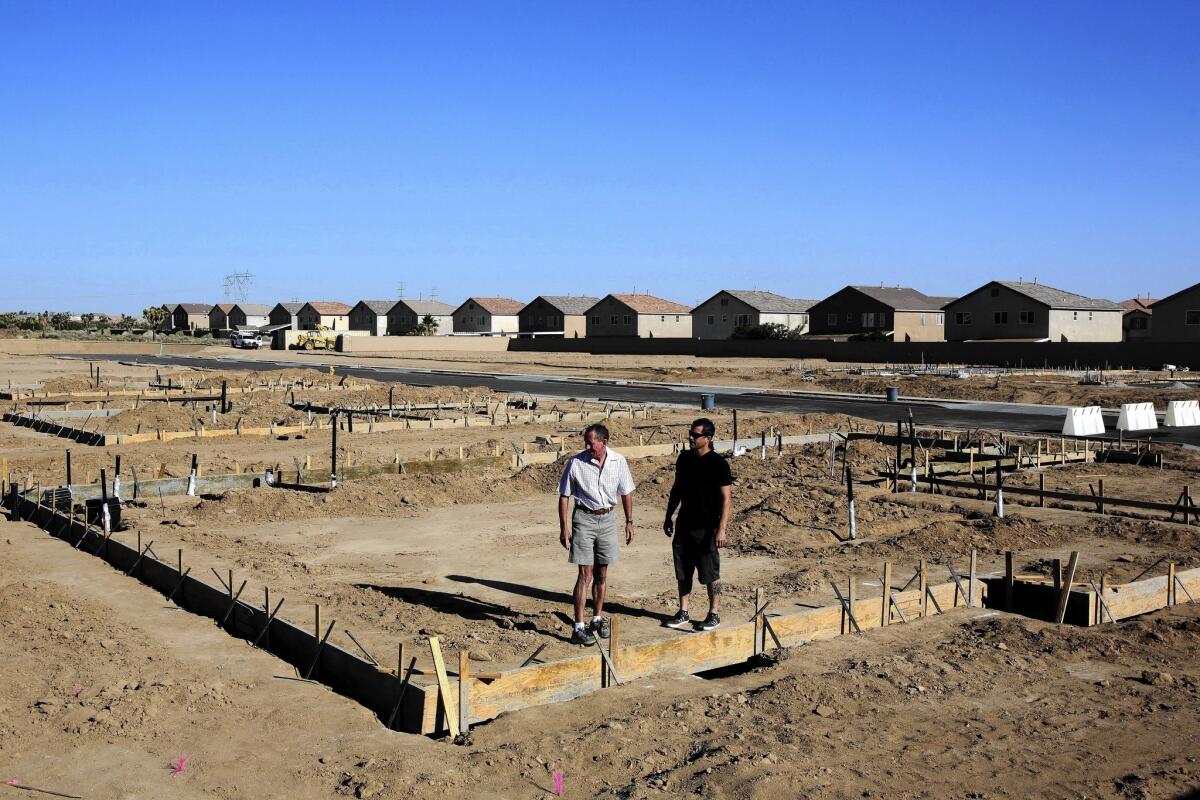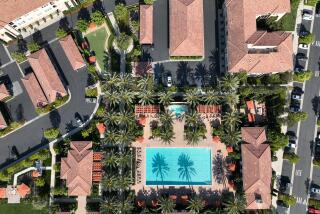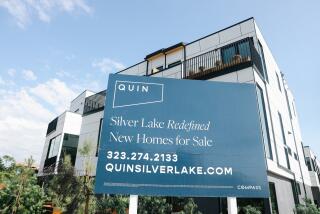Housing market recovering in High Desert town

This high desert town is seeing something it hasn’t in a long time: A row of houses being built.
The first new tract development in seven years is underway, the first rumblings of a home construction recovery in the ultimate boom-and-bust region of Southern California.
The 19 houses — phase 1 of a 40-unit project by a small company from Adelanto — is nothing compared with the thousands that went up each year across the Victor Valley about a decade ago. But in a place where builders walked away from whole subdivisions full of vacant lots, it may be a sign that the high desert’s housing market is finally beginning to heal.
“The market is getting back to something resembling normal,” said John Husing, an economist who studies the Inland Empire.
Victor Valley’s median home price has climbed 25% in the last year to $176,000, according to figures from Shear Realty. That’s the highest its been since July 2008, though still far less than the $295,000 found “down the hill” in Riverside County. Foreclosure sales, dominant a few years ago, are down to a sliver of the market. And real estate agents say good homes are hard to come by.
That’s tempting builders, especially in Hesperia — the first town north of the Cajon Pass — which cut its development fees last year to lure new construction.
Growth has often come in waves in Victor Valley, consisting of a string of cities straddling Interstate 15 north of the Cajon Pass. When the market heated up, builders bought dusty lots cheap and erected new homes for middle-class families who had been priced out of points closer to the coast. When the market cooled, the high desert froze.
A surge of home building in the 1990s was followed by a years-long dry spell. Then came the 2000s, when new subdivisions sprouted — more than 6,000 homes a year. From 2003 to 2006, prices more than doubled, with the typical new house going for $353,000.
Then prices fell by half in the recession, leaving many homeowners owing more on their new house than the house was worth. Home building fell sharply, and with it the good construction jobs. Unemployment in Hesperia hit 17%.
“It’s always been a boom-and-bust place, but that bust was the worst,” said Dino DeFazio, who’s been building homes in Hesperia since 1992.
The scars remain, in abandoned lots that are turning back to desert, in streets bumpy from deferred maintenance, and in signs advertising space in never-built shopping plazas along major streets off Interstate 15.
But now there are signs that the housing market here is stirring again.
In the last 12 months, the city has issued 49 permits for new single-family homes. That’s a fraction of the 1,706 it issued in 2005, but for a city that had 11 in the prior five years, it’s a noticeable bump.
“Things are slowly moving forward again,” Hesperia Mayor Thurston Smith said. “I think people are maybe starting to get off the fence.”
Most of those are small projects, like the three houses DeFazio is building in a subdivision he’s owned since the late ‘90s. But one company, Sorrento Homes Inc., is taking a bigger bite: a 10-acre tract project that’s slated to hold 40 houses when it’s finished.
Sorrento President Michael Howarth and his partner Alan Colantuono say they saw an opportunity in the tight inventory and demand for affordable new houses in Hesperia. So last summer they paid $90,000 for 10 acres of desert next to an abandoned softball field.
“Nobody had really come in here yet,” Howarth said. “We decided we’re going to put our butts on the line.”
Now Sorrento has a big sign on Main Street pointing the way to its development, a row of flags waving passers-by into three model homes, furnished and priced from $242,000 to $282,000. Howarth is aiming to have five more houses finished by fall.
Other builders are watching closely. Smith said the city has had preliminary inquiries about starting up other tract projects.
“As the word gets out that he’s sold six, eight, 10 homes, I think that will trigger some more guys to say ‘we’ll give it a shot,’ ” he said. “There is very low inventory up here.”
John Miller, an appraiser in Lucerne Valley who tracks land sales in the high desert, says builders are accumulating lots, and, if home prices go up an additional 5% to 10%, many of them will start building again.
“The last few years have been like the undertow, with everything pulling back,” Miller said. “But now you can … see that wave forming out there.”
If the wave hits, the high desert will face a familiar challenge: How to manage growth without being swamped by it, and how to avoid the next bust.
Victorville is considering a plan that would require future development to be on larger lots — at least 10,000 square feet instead of the current minimum of 7,200. The idea, said acting Director of Development Chris Borchert, is to attract higher-quality, higher-priced houses. But builders are pushing back, saying this would increase development costs with no real benefit. The plan is on hold.
In Hesperia, city officials have cut development fees to woo new construction, but say they’re focused in the long term on creating a local economy around far more than home building.
“Those are short-term jobs. We can’t just build houses and more houses,” said Smith. “We’ve got to stimulate commercial and industrial development and bring more business to town.”
So he’s out touting industrial sites, and marketing land around a new railroad line downtown and a new interchange off Interstate 15. Hesperia — and the whole Victor Valley — needs to transition from a bedroom town for long-haul commuters into its own self-sustaining economy, Smith said. That will help stabilize the housing market, he said.
Miller sees more good jobs coming, pointing to a new hospital under construction in Victorville. Neighborhoods in this still-young exurb are becoming more established, he says, more like older suburbs closer in. “The high desert is really beginning to shape out, to define itself,” he said. “That’s really a first.”
For now, though, builders such as Howarth just want to sell a few houses.
Sorrento’s had good foot traffic through its sales office, which opened about a month ago, first from curious neighbors and increasingly from serious buyers. Sorrento has two houses under contract and several more awaiting loan approvals.
He’s eager to catch the start of a new wave.
“Hopefully our timing is good,” he said.
Twitter: @bytimlogan







